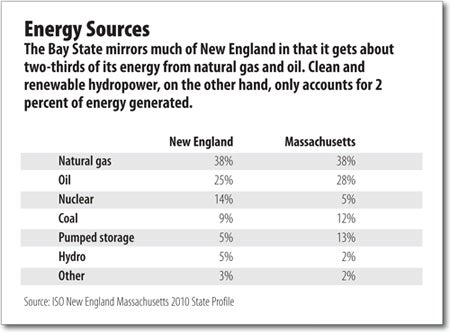When the subjects of energy efficiency or the green economy are discussed, solar and wind power dominate the discussion. But hydropower, which has been employed in Massachusetts for 300 years, tends to be overlooked.
But according to experts, today’s newer power sources have a lot to learn from hydropower. And just because it doesn’t get the attention the others do doesn’t mean hydropower isn’t on the cutting edge of innovation.
New And Old
The lack of hype compared to solar and wind power isn’t all because solar and wind are just so sexy.
Hydro “is in a different portion of the development cycle than solar or wind,” said Phil Giudice, commissioner of the state Department of Energy Resources. “The hydropower put in place 100 years ago is still working” while solar and wind fight for public support and acceptance, he said.
And because the technology is so old, many of the waterways suitable for generating hydropower have already seen the development of hydroelectric facilities.
“You need a breakthrough in technology” to get more widespread use of hydropower these days, Giudice said. Compare that with solar power, which seems to undergo a technological breakthrough as fast as the last great breakthrough can be commercialized.
Some of those hydro technologies exist. In fact, the free flow turbine, a hydroelectric power generator that has no need for a dam, is very promising but very expensive.
So, in small numbers, traditional hydro projects still pop up. Earlier this year, the Massachusetts Clean Energy Center gave $600,000 in design and construction and upgrade grants to hydropower projects totaling about 1 megawatt in capacity.
One of the grants was to study the feasibility of improvements to the city of Fitchburg’s Narrows Road station.
New Generation
Hydropower generates about 2 percent of Massachusetts electricity, according to ISO New England, and about 5 percent of New England’s. The state and the region are dominated by natural gas and oil, which combined make up about two-thirds of the electricity generation in the state and region.
In order to meet the state’s Renewable Portfolio Standard, utilities and power suppliers must get a certain percentage of the electricity they provide from renewable sources.
To do that, utilities and suppliers rely most heavily on biomass, which accounted for nearly 40 percent of renewable power generation in 2008, according to DOER. Landfill gas and wind were close behind, with wind accounting for 24.5 percent of renewable generation.
Solar accounted for only 0.1 percent.
Where solar power is beholden to the sun, hydro, which doesn’t even register on the renewable portfolio standard, has several other obstacles, such as fish passage, navigation and access for recreation, for example. Those concerns are heaped upon the need for better water control and better water management, Giudice explained.
However, if done properly, hydropower can be very reliable where “wind is intermittent and solar is intermittent,” Giudice said.
The most intermittent thing about hydro may be its cost, Giudice said.
“New hydro can be extremely expensive or inexpensive,” he said.

